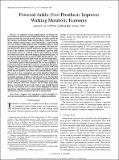Powered Ankle–Foot Prosthesis Improves Walking Metabolic Economy
Author(s)
Au, Samuel K.; Weber, Jeff A.; Herr, Hugh M
DownloadAu_Powered-Ankle-Foot.pdf (1.480Mb)
PUBLISHER_POLICY
Publisher Policy
Article is made available in accordance with the publisher's policy and may be subject to US copyright law. Please refer to the publisher's site for terms of use.
Terms of use
Metadata
Show full item recordAbstract
At moderate to fast walking speeds, the human ankle provides net positive work at high-mechanical-power output to propel the body upward and forward during the stance period. On the contrary, conventional ankle-foot prostheses exhibit a passive-elastic response during stance, and consequently, cannot provide net work. Clinical studies indicate that transtibial amputees using conventional prostheses have higher gait metabolic rates than normal. Researchers believe that the main cause for these higher rates is due to the inability of conventional prostheses to provide sufficient positive power at terminal stance in the trailing leg to limit heel strike losses of the adjacent leading leg. In this investigation, we evaluate the hypothesis that a powered ankle-foot prosthesis, capable of providing human-like ankle work and power during stance, can decrease the metabolic cost of transport (COT) compared to a conventional passive-elastic prosthesis. To test the hypothesis, a powered prosthesis is built that comprises a unidirectional spring, configured in parallel with a force-controllable actuator with series elasticity. The prosthesis is shown to deliver the high mechanical power and net positive work observed in normal human walking. The rate of oxygen consumption and carbon dioxide production is measured as a determinant of metabolic rate on three unilateral transtibial amputees walking at self-selected speeds. We find that the powered prosthesis decreases the amputee's metabolic COT on average by 14% compared to the conventional passive-elastic prostheses evaluated (Flex-Foot Ceterusreg and Freedom Innovations Sierra), even though the powered system is over twofold heavier than the conventional devices. These results highlight the clinical importance of prosthetic interventions that closely mimic the mass distribution, kinetics, and kinematics of the missing limb.
Date issued
2009-01Department
Massachusetts Institute of Technology. Department of Mechanical Engineering; Massachusetts Institute of Technology. Media Laboratory; Program in Media Arts and Sciences (Massachusetts Institute of Technology)Journal
IEEE Transactions on Robotics
Publisher
Institute of Electrical and Electronics Engineers
Citation
Au, S.K., J. Weber, and H. Herr. “Powered Ankle--Foot Prosthesis Improves Walking Metabolic Economy.” Robotics, IEEE Transactions on 25.1 (2009): 51-66.© Copyright 2009 IEEE.
Version: Final published version
ISSN
1552-3098